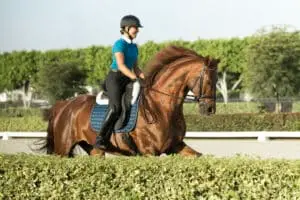
Five Stretching Exercises for Your Horse
Upgrade your routine! Keeping your horse in tip-top shape is crucial for his health and

As a rider, it is important to have a free, balanced and relaxed seat in order to connect well with the horse and steer it correctly and with ease. Unfortunately, sometimes blockages form in the seat that can disrupt this connection and lead to problems in riding. What are such blockages and how can they be solved?
Blockages in the seat can be physical or mental and can affect different areas of the body. Often it is tension in the pelvic area, in the lower abdomen or in the back that cause the rider to be unable to sit loosely and balanced in the saddle. Mental blocks, such as fear or lack of self-confidence, can also interfere with the seat and cause the rider to become tense or unsteady in the saddle. It is important to identify and address blockages in the seat early to avoid longer-term problems in riding. However, with targeted training and professional help, such blockages can be successfully released so that the rider can once again sit freely and balanced in the saddle.
To release blockages in the seat, there are several options. First of all, it is important to identify the cause of the blockage. Physical blockages can be treated, for example, by targeted stretching or strengthening of specific muscle groups. A trained physiotherapist or osteopath can help to identify the exact causes of the blockages and treat them in a targeted manner.
Here are a few exercises that can help release blockages in the seat:
It is important that these exercises are performed under the guidance of an experienced riding instructor or therapist to avoid injury and to get the most benefit from the exercises. It may also be helpful to consult a trained physical therapist or osteopath to specifically address the rider’s individual needs.
Mental blockages in the seat can also be worked on. This is where it can be helpful to work with a sports psychologist or therapist to identify and work on the causes of anxiety or lack of self-confidence. Training in concentration and relaxation, for example through yoga or progressive muscle relaxation, can also help to improve the fit.
It is also important to consciously take time to check and improve your own fit. To do this, it can be helpful to have an experienced riding instructor observe and correct you. Riding regularly in different disciplines and on different horses can also help improve one’s seat and remove blockages.
Download the Happie Horse App for free and get a 7-Day free trial for all the Premium Features!

Upgrade your routine! Keeping your horse in tip-top shape is crucial for his health and

These exercises will help you get fit in the saddle in the future What you

Do you want to set up poles or a small course, but don’t know how

Lunging is a popular way to exercise horses in a controlled environment and improve their

“Straighten your horse!”—every rider has probably heard this phrase from their instructor at least once.

What to do in case of inactive hindquarters? Hindquarter engagement plays a crucial role in